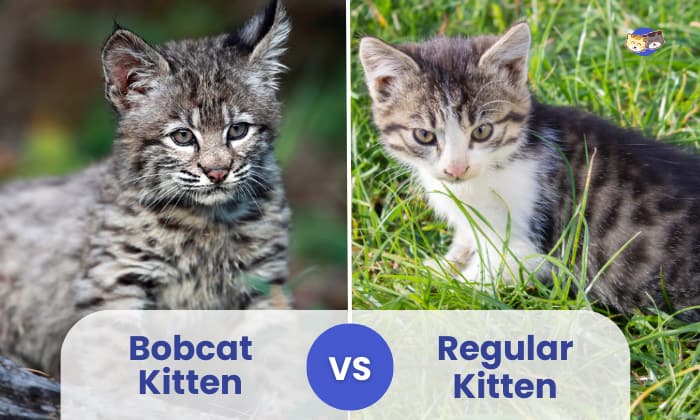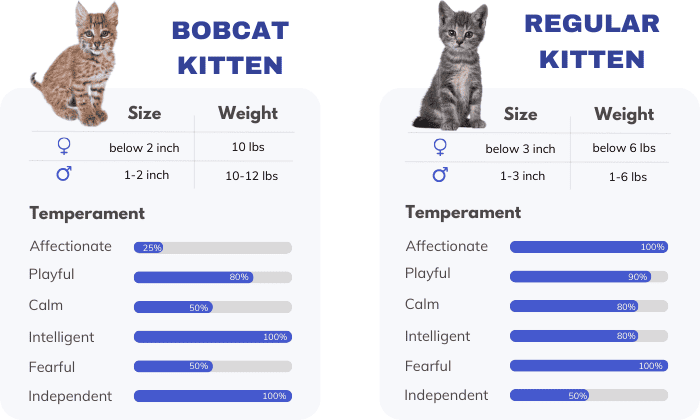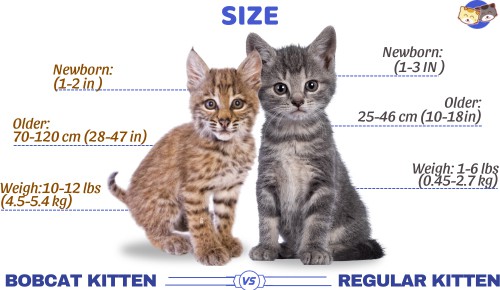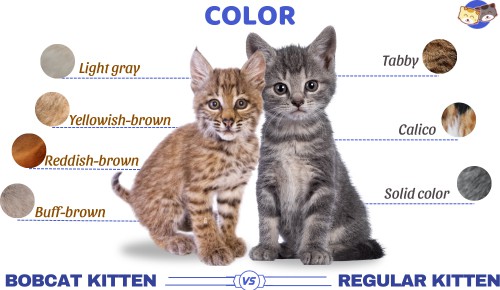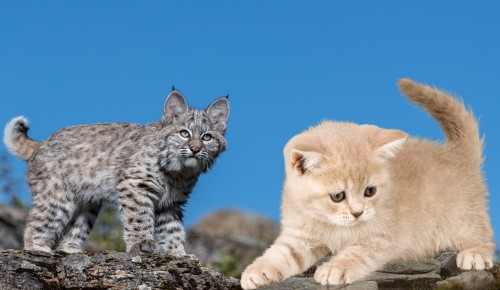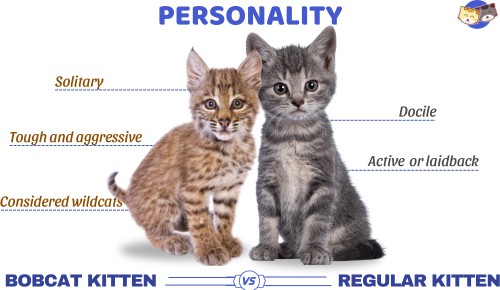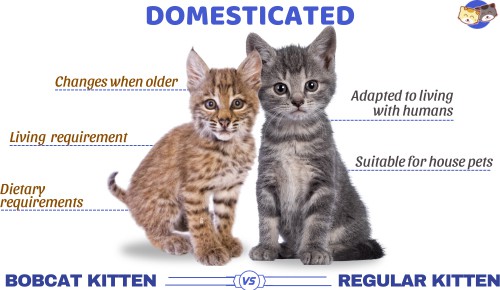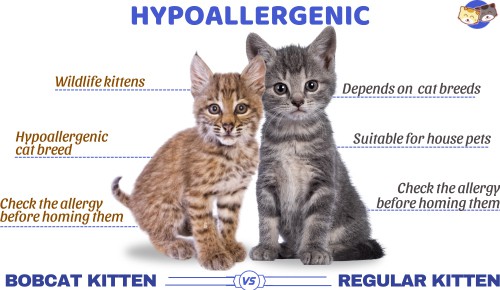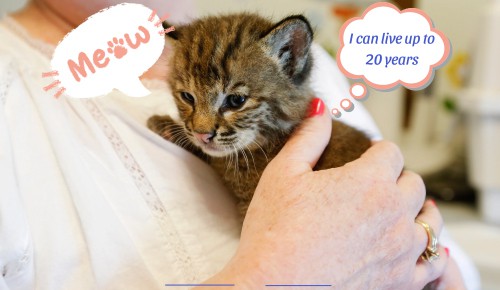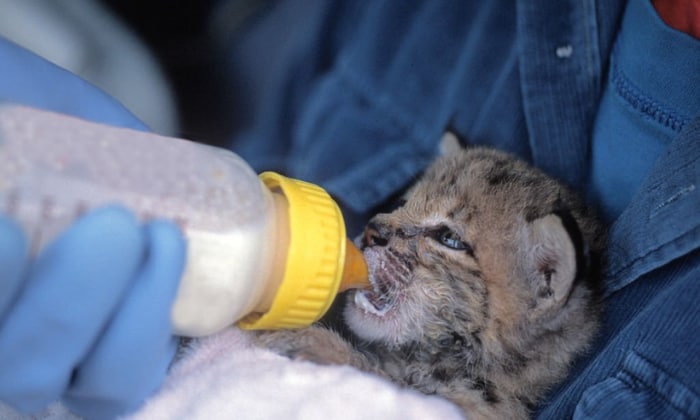So you found a new kitten in your life, but they may look a little different from what you expected. Do they have an odd pattern? Maybe their ears look a little pointier than usual? If so, perhaps they’re not a regular kitten after all.
In this article, we’ll be comparing a Bobcat kitten vs regular kitten, from their physical attributes to their personalities.
By the end, you’ll know whether or not you have a Bobcat kitten in your hands and figure out the next best steps.
| Bobcat Kitten | Regular Kitten |
|
|
Table of Contents
Overview
History suggests cats we know today have domesticated themselves into our lives as far back as 10,000 to 12,000 years ago. These accounts originated from the Middle East, as native wildcats settled near early towns, preying on rodents attracted to farm grains.
- Regular cats these days aren’t so different. They’ve been fully embraced into our lives and continue to chase rats and run around humans.
- Bobcats, on the other hand, are wildcats found from Southern Canada to Southern Mexico. They’re genetic cousins of the Canadian Lynx, a wildcat species native to Canada, parts of Alaska, and northern US states.
- Bobcats come in multiple shades of brown, with dark brown and black spots all over their bodies and black pointed-tip ears. Older bobcats develop prominent tufts on the sides of their face.
- Regular cats are more colorful as they can be white, red, blue, black, cream, cinnamon, fawn, and brown.
Similarities & Differences Between a Bobcat Kitten vs. Regular Kitten
Though Bobcat kittens may produce sounds similar to regular kittens, they’re ultimately different breeds. Here we’ll be focusing on how to tell if you have a bobcat kitten by comparing their qualities.
1. Size
As kittens, the newborn bobcat isn’t far in size compared to newborn kittens, which is around 2.5-7.6 cm (1-3 inches). When they grow older, they can be about 70-120 cm (28-47 inches) lengthwise and 36-38cm (14-15 inches) tall.
A domestic cat is around 46 cm (18 inches) lengthwise and 25 cm (10 inches). Making adult bobcats twice the size of your average cat.
In terms of weight, a bobcat kitten size is 10-12 lbs (4.5-5.4 kg) as a young adult, and the regular kitten’s weight is 1-6 lbs (0.45-2.7 kg).
2. Color
Both bobcats and regular kittens come in different colors and patterns, which can make identification tricky.
Regular kittens vary in colors and patterns like the tabby, calico, solid color, and more.
Bobcats come in light gray, yellowish-brown, reddish-brown, and buff-brown, with distinct brown and black spots around them. They are sometimes confused with other species like the Canadian lynx, the Iberian lynx, and the Eurasian lynx.
3. Appearance
To identify a bobcat kitten vs a regular kitten, there are 6 traits you may want to know:
| Bobcat | Regular cat | |
| Head shape | Small faces with facial tufts on the sides. | Compact and rounded features. |
| Eye shape | Yellow eyes and black pupils. | Varies, but most common an almond-like shape. |
| Ear Shape | Sharp pointed ear tips with tufts of fur going down the sides of their face.
They also have black stripes lining the tips of their ears, similar to lynx cats. |
Triangular ears with rounded tips. |
| Body shape | Medium-sized, but can grow twice the size of a domestic cat. | Varies, where they can be petite or large. Most commonly, they are muscular and slender. |
| Fur Coat | Spotted patterns across the body | Fur can come in various lengths from short to long, and the patterns can come in tabby (dark-streaked), calico (tri-colored), or solid. |
| Tail shape | Short and bobbed tails | Tails can come in various lengths |
But what about domesticated bobcat hybrids?
While it was earlier believed that there have been half-bobcat kittens or house cats mixed with bobcat kittens. Studies show domesticated cats and Bobcats cannot produce healthy offspring and have misidentified the hybrid for the American Bobtail.
4. Personality
Bobcats are often solitary and considered tough and aggressive as they’re still considered wildcats.
Regular cats are more docile. Some can be active while other regular cats are more laidback.
5. Domesticated
Regular cats and kittens have adapted to living with humans. Bobcat kittens may be similar to regular kittens when they are infants, but that changes as they grow.
You would need to adjust their living arrangements to accommodate their size, behavior, and personality, including changes to their dietary needs.
While it’s possible to house bobcat kittens, depending on where you are and your local animal laws, they’re still wildcats and are unsuited as house pets as they pose major safety concerns for your home.
6. Hypoallergenic
Bobcat kittens are considered wildlife kittens, and aren’t known to be hypoallergenic. As for regular kittens, it depends as only a few known cat breeds are considered hypoallergenic.
The reaction still depends on the person’s allergen sensitivity. So, a potential owner will need to spend time with the cats before homing them.
7. Lifespan
Bobcats and domestic cats have an average life span of 12-14 years. Though, bobcats can live up to 20 years in captivity vs the wild.
What Should I Do if My Cat is a Bobcat Kitten?
If your cat is a bobcat kitten, it’s best to call the proper authorities, like animal control to help address the situation.
If you intend to keep them, consult with local laws and experts as well as with veterinarians experienced with wildlife and/or exotic animals, as they’ll need specialized care.
Conclusion
Bobcats and regular cats share plenty of common physical traits, but are still different creatures that require different care. Whether or not you have a bobcat kitten vs regular kitten, it’s best to be prepared and know how to care for your furry friends.
It is crucial to keep in mind the safety concerns of homing a bobcat kitten, as it’s still advised for them to be in the wild. That said, we hope this has been helpful to you in knowing the difference between the two kittens.

I am Amy Sawy, a Doctor of Veterinary Medicine (DVM) graduate from the University of Kansas. y husband, Dr. Plummer, and I own a veterinary clinic in Phillipsburg, Kansas. In addition to my professional background, I am a devoted pet owner myself, with a household that includes dogs, rodents, and most notably, cats – a total of five felines in my home.
In 2020, I joined an organization as a professional writer, leveraging my experience and collaborating with my team to deliver the most valuable information for your cat’s care.


